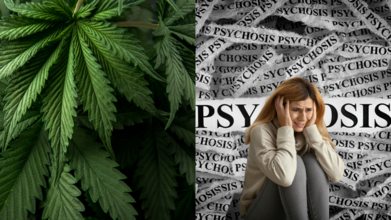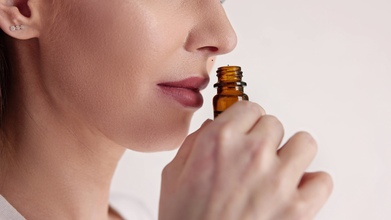- Health Conditions A-Z
- Health & Wellness
- Nutrition
- Fitness
- Health News
- Ayurveda
- Videos
- Medicine A-Z
- Parenting
- Web Stories
The Rise of Cannabis-Induced Psychosis in the UK: What It Is and Why You Should Know

Credits: Canva
Cannabis-induced psychosis is becoming increasingly common across the UK. With stronger strains easily available and a perception that weed is harmless, doctors are seeing worrying consequences for mental health.
What Exactly Is Psychosis?
Psychosis is not just a medical term; it describes a mental state where someone loses touch with reality. A person in a psychotic episode may hear voices, see things that are not there, or believe unusual ideas with unshakeable certainty. Everyday surroundings feel warped, thoughts become jumbled, and behaviour can change dramatically. These episodes can last days, weeks, or longer, and while many people recover, some continue to experience symptoms for years.
Psychosis is not a condition in itself but a symptom of underlying mental illnesses such as schizophrenia, bipolar disorder, or drug-induced disorders. And cannabis, once dismissed as a “soft” recreational drug, is increasingly proving to be a serious trigger.
Cannabis and Its Dark Side
The UK has no shortage of cannabis users. In the year to March 2024, about 2.3 million people reportedly admitted to using the drug. But while regular use has halved over the past two decades, psychiatrists are alarmed by a sharp rise in cannabis-induced psychosis cases. The problem is potent modern strains and the growing popularity of “skunk”.
Skunk is produced from unpollinated cannabis plants with naturally higher levels of THC, the psychoactive compound responsible for the drug’s “high”. Unlike traditional varieties, these turbocharged versions can push the brain into paranoia, hallucinations, and even long-term mental health conditions.
The Risk Behind the Smoke
According to reports, the public health problem is deepening. There has been a visible rise in the number of people needing intensive support for psychosis as a result of cannabis use. What begins with smoking a few ‘joints’ and feeling a bit paranoid can easily escalate.
The issue is compounded by the fact that cannabis is readily available online. High-strength weed can be bought and delivered with the same ease as ordering a takeaway. For some users, that ease leads them into dangerous territory. Over time, repeated exposure to potent cannabis does not just spark temporary paranoia; it can cement itself into a chronic psychotic state.
How Cannabis-Induced Psychosis Feels
For those caught in its grip, cannabis-induced psychosis can be terrifying. Hallucinations distort familiar environments, creating confusion and fear. Dissociation leaves people feeling detached from their own bodies or surroundings. Everyday interactions can feel hostile or threatening, and the person’s sense of what is real becomes fragile.
While these symptoms may fade once the drug wears off, for some they linger, leading to severe depression or even suicidal thoughts. Studies suggest cannabis can also trigger schizophrenia in vulnerable individuals, an illness characterised by recurring psychotic episodes, delusions, and long-term disability.
Why Skunk Is Different
You might wonder, why is today’s cannabis so much more risky? The answer lies in THC levels. Traditional cannabis varieties contained lower amounts of this psychoactive compound, and many also carried cannabidiol (CBD), a chemical thought to counteract some of THC’s mind-altering effects. Skunk, however, has been bred to maximise THC and reduce CBD.
This results in a product that is stronger, more destabilising, and far more likely to provoke psychosis. While occasional users may brush it off as a “bad trip”, for others, the effects can be life-altering.
A Growing Health Crisis
Despite the popular image of cannabis as a “chill” substance, psychiatrists are dealing with an entirely different reality. Hospitals and rehab centres across the UK are seeing more young people admitted with psychosis linked to cannabis. Over time, people can reach a psychotic state which would not go away, even if they stop smoking. They can become very depressed or suicidal.
The public health implications are significant. Not only do psychotic disorders put immense strain on the NHS, but they also derail lives, disrupting work, education, and relationships.
Rethinking “Harmless” Weed
The narrative around cannabis has long been tangled. To some, it is a natural plant, a stress reliever, even a medicine. But the reality is more complicated. Yes, cannabis contains compounds with therapeutic potential, but when engineered for potency and consumed regularly, it can become a gateway to enduring mental illness.
People need to know that today’s cannabis is not the same mellow joint their parents smoked in the 1970s. It is stronger, riskier, and capable of tipping vulnerable minds into frightening psychological territory.
Your Sense Of Smell Could Decide How Long You Live, According To Doctor

Credits: Canva
Smell is a sense that helps us navigate, feel, and in fact remember things. Thanks or not, but Covid-19 also helped us know its importance, when many people lost the sense of their smell, as one of the major COVID-19 symptom. But, that is not just it, in a podcast posted on Instagram Dr Sanjay Bhojraj, board-certified interventional cardiologist talked to Dr Michael Leon, PhD Professor Emeritus of Neurobiology and Behavior at the Charlie Dunlop School of Biological Sciences on surprising link between smell and overall well-being.
Can Smell Predict How Long Will You Live?
“By the time you reach middle age, your sense of smell can actually predict all-cause mortality,” says Dr Leon. “That means whether you live or die, for any reason, can be accurately reflected in your ability to detect odors.”
The expert says that out olfactory system bears a direct impact to the brain's memory and emotional centers. “It has a great deal of impact when you lose it. And also when you amplify it. When you smell a pleasant odor, it activates the cerebellum and increases sniffing. For example, when you smell a rose, you naturally take a deep sniff.”
How Does Smell Impact Your Brain?
When you encounter a bad or disgusting odor, your body reflexively stops respiration. You instinctively avoid breathing it in,” Dr Leon says.
The expert said it is these subtle responses that influence one's memories, emotions, and overall brain function. “The olfactory system is just much more powerful than most people realize,” he says.
Can Body Odor Also Reveal Things About Your Health?
This link between smell and health became famous when Joy Milne, a retired Scottish nurse, claimed she could detect Parkinson’s disease by scent alone. Years before her husband’s diagnosis, she noticed a distinct musky odor on him. When she later met others with Parkinson’s, they all carried the same smell. Curious scientists put her to the test — and she correctly identified patients just by sniffing their shirts, even predicting one man’s diagnosis a year before doctors confirmed it.
Her unique ability led researchers like Professor Perdita Barran at the University of Manchester to discover that people with Parkinson’s excrete specific lipid-like molecules through their skin. These include hippuric acid and octadecanal, which may form the disease’s distinct odor. Barran’s team is now developing a simple skin-swab test that could help doctors detect Parkinson’s much earlier.
Different diseases create different odors. For example, a fruity or “rotten apple” smell can indicate uncontrolled diabetes, caused by a build-up of ketones. A fishy or ammonia-like scent might suggest kidney problems, while a musty smell could point to liver disease. Even infections leave olfactory traces — cholera, tuberculosis, and C. difficile each produce distinct, unpleasant aromas.
Is It Possible To Get The Same Cold Twice?

Credits: Canva
Did you also wake up with a mild cold? A sneeze, blocked nose and a sore throat. It is worse because you had just shaken off the miserable cold and your energy was finally coming back and then now again you are sneezing. So, now the question is, could you really get the same cold twice, or is it just your bad luck?
As per the National Health Service, UK (NHS), adults could get an average of 2 to 4 colds a year. The NHS, UK notes that the viruses behind them behave in a complicated way. This is because some mutate quickly, and some stay in your system. This is why your body's ability to fight them off can differ depending on how well does your immune respond.

Catching The Same Cold, Twice
Conventionally, it is believed that once you have a virus, your body recognizes it and does not let you catch the same virus again. However, this is not the case, always.
Professor Brain Ferguson, who is the professor of viral immunity at the University of Cambridge told Yahoo UK, that it is possible to catch cold twice. This is due to the levels of antibodies that we have in our system.
Ferguson says, "It depends on the quality of the antibodies that your body generates when you get infected the first time. Sometimes your body might make really good ones, and that will stop you being reinfected with the same virus later. But another person might not, and they can catch the same virus, exactly the same one, again later."
The expert further added, "It is also down to the actual molecules, and the constituents of the virus, like proteins and things you make antibodies against. The longer they exist in your body, the better the antibody response tends to be."
This means that the cold can stay in your system, and the longer it stays the better your immune system will be prepared to build up a stronger defense.
Reinfection Time: How Long Does It Take?
If you had two colds very close together, you may not have had enough time to build immune response the first time. Ferguson says, "Reinfection can be very fast."
"It can be as soon as a couple of weeks if the antibody response is very weak... You might pick up a virus and get a few minor symptoms, but fight it off really quickly. In that case, you get much weaker antibodies that fight the virus, which means the same virus appears in your system again very quickly."
This means your body only has a "fleeting encounter" with the virus and thus it won't remember it well enough to protect you the next time. However, a more severe cold may trigger a stronger immune response, which can work as a longer-lasting protection.
Why Some People Catch More Often?
This has something to do with genetics. This is because of their immune system, how good it works against different infections. As Ferguson says, "Some people are just naturally better or worse at fighting off viruses or bacteria due to their genetic makeup."
While it is believed that multivitamins and supplements can help "boost" immunity, Ferguson says that the evidence is mixed.
There’s not a great evidence base for [vitamins] for repeat infections," he says. However, Ferguson adds there is evidence that people who spend more time outside and get more vitamin D tend to have a slightly better-functioning immune system.
Harvard Physician Sue Goldie Finally Reveals After 4 Years About Her Parkinson's Disease

Credits: Harvard TH Chan
"I wouldn't use the word hide," said Dr Sue Goldie to NPR, she is a professor at the Harvard TH Chan School of Public Health, who has finally told the world after four years about her Parkinson's.
She learned about her diagnosis in 2021. She told NPR, "I think I was really trying to give myself room and time to fall apart, to panic, to think about what it meant for me.” For Goldie, silence wasn’t secrecy, it was self-preservation.
She revealed she needed space to understand to first accept that it is happening with her, and secondly to understand how to live with a condition that would alter her movements, her voice, and even her sensing. So she calls the 4-year-gap of not telling anyone as a "process of figuring out how I could be OK."
Parkinson's Disease: How Does It Start?
We often read about Parkinson's disease, what is it, and what it does to someone. However, what we do not talk a lot about is how it starts. We don't talk about the subtle signals one's body sends.
Goldie says it started with a tremor. It was so slight, that it was almost invisible. Then, a running coach mentioned her off cadence. The New York Times (NYT) reports that a trainer noticed her left arm did not lift properly in the pool. Eventually, afterwards, her fingers began twitching. Goldie, then was 50.
She was also at the height of her academic career and was newly obsessed with triathlons. She was in fact, training for Ironman races, reported NYT.
When tests confirmed Parkinson’s, a degenerative neurological disease that affects movement and coordination, her first reaction was disbelief. Then fear. Would her students notice? Would colleagues see her differently?
The diagnosis left her confronting an identity crisis. At what point, she wondered, does a disease become who you are?
Sue With Parkinson's, Who Lived Two Lives
Goldie began to divide her world. At Harvard, she was the confident professor and global health leader, still producing intricate teaching materials and mentoring students. In triathlons, she was freer, surrounded by people who saw her as an athlete, not a patient.
But the effort to maintain that balance came at a cost. As reported by NYT, early mornings were the hardest: walking unsteadily to the bathroom before medication took effect, hiding tremors from colleagues, managing the dopamine pills that controlled her symptoms. “You have no idea how hard it is to trick you into thinking I’m OK,” she later said.
Eventually, she could no longer keep it private. “Starting today, I am Sue with Parkinson’s,” she decided. Most of the people in her professional life would learn about it through her story.
The Camera For Healing
When Goldie's hand tremors made writing impossible, she began to record thousands of video diaries. They were often short, unfiltered glimpses of her daily struggle, which were filmed in her office, car, or home. Sometimes, calm, sometimes in tears.
Her videos began with a "Hello Sue", talking to her future self. In one video as posted by the NYT from 2023, she confessed, “I’m trying hard to do all this stuff that will help, but I’m not feeling OK... I just need to not be alone with it.”
Goldie refused to stop training. Her research had shown that exercise helps manage Parkinson’s symptoms. So, she doubled down, calling herself “an N of 1” — a one-person experiment. She adapted creatively: pink tape on her hands to guide her swim strokes, modified gear on her bike so she wouldn’t lose balance.
In 2022, she completed the Lake Placid Ironman, a 140.6-mile challenge. She crossed the finish line after collapsing, crying, and reapplying lipstick. Her small team called her S.F.G., with the middle initial standing for an unprintable word that captured her spirit.
As her symptoms progressed, Goldie’s fears shifted from physical decline to the erosion of identity. Parkinson’s, she realized, isn’t just about tremors; it’s about dignity, perception, and the quiet grief of being misunderstood.
She worried about whispers at Harvard, about whether others would still see her as capable. When she finally told university leaders, she felt both vulnerable and relieved.
Still, her mission remained unchanged. “I can’t change this,” she told The New York Times in 2024. “So what happens when I get worse?”
She continued teaching, designing, and mentoring. Her hands might tremble, but her mind stayed sharp. “I want to get things done while I’m still the best me,” she said.
© 2024 Bennett, Coleman & Company Limited

